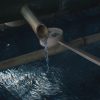Microbots Made from Mushroom Spores Could Clean Polluted Water
Heavy and toxic metals, including lead, can cause serious health problems such as reduced growth and development, cancer, organ damage, or nervous system damage if they leak into our water. In fact, lead exposure through water accounts for almost half a million deaths each year.
Luckily, scientists at the Advanced Nanomaterials and Microrobotics Laboratory (ANML), a part of The Chinese University of Hong Kong, recently discovered that iron-oxide coated microbots made from mushroom spores could help in removing these heavy metals from contaminated water. Similar to a robot but on a much smaller scale, a microrobot is a miniaturized machine designed to perform a specific task or tasks repeatedly and with precision.
How does it work?
First, an external magnetic field is used to move the microbots around. Once the microbots come in contact with polluted water, the mushroom spores attached to the microbots attract and take hold of the heavy/toxic metals. The microbots and contaminated water are then transferred with the same magnetic field.
It’s important to note that these microbots cannot take out all pollutants. They can, however, remove small amounts of pollutants to reduce overall contamination. In areas with water close to or just at toxic levels such as Reno, NV and Ponoma, CA, this small change can be the difference between drinkable water or non-potable water.
LEARN MORE
Magnets are also being used for recycling, and researchers are finding ways to recycle these rare earth magnets. You can read about it here in our recycling roundup. For more information on how magnets are influencing the environment, browse through some of our other industry topics or contact us today.

